What’s a house without a few houseplants? Well…still a house. BUT you have to admit that keeping plants around the home really spruces the place up. *wink wink*
Puns aside, the benefits of indoor plants have been documented and studied on multiple occasions. From health to interior design choices, these little buddies could be just what you need to add the vibrancy of greenery to your living room or kitchen.
Now, what about the bedroom?
Where you sleep is a sacred space, so you might want to consider all the factors involved in having bedroom plants.
Let’s take a look at the pros and cons of plants in the bedroom, and the best indoor plants for you to choose from.
Related: Ecosa Mattress
Pros of Having Bedroom Plants
1. Clearing the Air
While we try to keep our spaces tidy and dust free, few of us are aware of the hidden everyday dangers that float around our homes.
Trace chemicals found in common household items like inks, paints, plastics, cleaning agents, rubber, and even paper products – as indicated in NASA’s research on the topic – can seep into the air we breathe without us knowing. These indoor air pollutants affect us and cause respiratory problems more than we realise.
The same study indicated a significant reduction in air pollutants as a result of adding indoor plants to the room. They are our natural air purifiers. There are plants that help remove toxins and allergens from the air. So, imagine the wonders it can do for the air quality in your bedroom space!
2. Regulating Humidity
Humidity levels can be a factor that affects your sleep, even if you aren’t always aware of it. Studies have shown that indoor plants help regulate the relative humidity of indoor spaces, making them more naturally comfortable for our human bodies.
3. More Positivity, Less Stress
Trying to soothe yourself and forget about the day’s worries is key to a peaceful sleep. It is important that your bedroom reflects the kind of zen that you want to achieve before catching some Zs.
Several studies indicate an increase in positivity and reduction in stress from having indoor plants in experiments conducted in workspaces. Still, the same things can be said about your sleeping space. Ending the day on a positive note and with lower stress levels can only lead to a higher chance of better sleep.
4. Reducing Physical Discomfort
The health benefits of house and bedroom plants don’t end there. This might seem like a bit of a stretch at first glance, but plants can influence your physical well-being.
As mentioned earlier, one part of it is addressing air pollutants in indoor spaces. The same NASA study noted “sick building syndrome”, wherein synthetic materials in buildings release toxins that make people sick.
Adding indoor plants to the space absorbs these chemicals and alleviates health problems like “itchy eyes, skin rashes, drowsiness, respiratory and sinus congestion, headaches, and other allergy-related symptoms”.
This has been supported by other studies that have also pointed out similar results in workspaces with plants compared to those without.
If you think your building might have a similar situation, looking to do the same for your bedroom (and your home in general) might help with some of those problems.
Cons of Bedroom Plants
1. Critters
This might be nit-picking, but it’s important to note that living organisms like plants might invite a few other creatures to nest in their mini biome.
People have been putting plants in their homes for many many years, so it shouldn’t be a big problem. Just keep an eye out and address the problem early if it ever comes up.
Nip it in the bud, so to speak.
2. Carbon Dioxide
Plants release oxygen much more in the day when photosynthesis happens. Whether they are in the presence of direct sunlight or indirect sunlight, it is during this time that they convert carbon dioxide and water into sugar for food.
But it is incorrect to assume that all plants always release fresh oxygen, even at night. Truth be told, many plants release carbon dioxide at night.
But there’s nothing to worry about. Really really small amounts of carbon dioxide won’t be a problem for humans. A few plants will never produce enough to be harmful, maybe unless you are sleeping in some sort of a jungle… Plus, it’s all about plant selection.
The bigger problem is carbon monoxide, which plants like the Chinese Evergreen or Golden Pothos help absorb.
3. Maintenance
Not everyone has a green thumb, and while this con isn’t specific to bedroom plants only, always keep in mind that plants need love and care too. This might take up some of your time and resources, depending on the plant you decide to get so make sure you’re willing to commit.
4. Feng Shui
According to many Feng Shui experts, plants are not suitable for the bedroom because they produce energy that contradicts your sleep. On the flip side, some experts believe that there are still some plants that are good feng shui for the bedroom.
You may see incompatible takes on this topic. Dozens of feng shui schools have slightly varied teachings. It depends on the practitioner.
While the historical context of feng shui may no longer be relatable in today’s living standards, at the end of the day, it’s all about your beliefs. If you do decide to have a plant in the bedroom, be sure to find one that’s appropriate for the space and for you.
The Best Bedroom Plants – They’re Super OK to Have!
Now that we’ve looked at the pitfalls and benefits of houseplants, it’s time to look at the best plants. When picking out the best bedroom plants, look at several things before buying a pot.
They should:
- be easy to care for (low maintenance so it survives even when you forget to water it)
- be able to clean the air of toxins
- preferably be able to thrive in the shade
- go with the room’s aesthetic (of course)
NOTE: Always check if the plants you are choosing are safe for any pets you may have at home in the event that these plants are accidentally ingested.
English Ivy
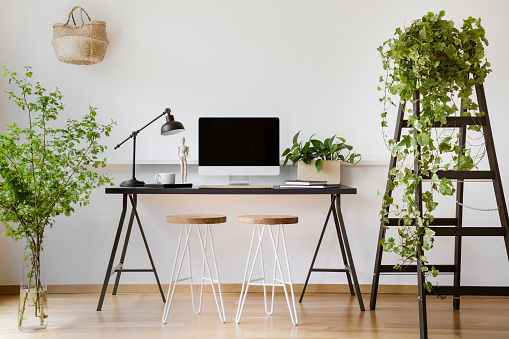
One of the plants used in NASA’s famous experiment, the English Ivy clears the air of harmful toxins like benzene, formaldehyde, xylene, and trichloroethylene. Not difficult to care for, this crawling plant is a charming addition to your bedroom
TIP: Get creative! Allow your English Ivy to grow in unique paths and patterns to suit your style.
Succulents and Cacti
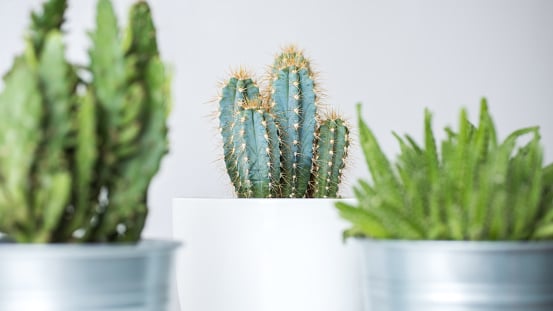
Some of the easiest green buddies to take care of, these low-maintenance plants are a favourite of first-time plant owners – especially those who aren’t gifted with a green thumb. Just plop one on your bedside table and begin your journey as a plant lover.
Snake Plant or “Mother-in-Law’s Tongue“
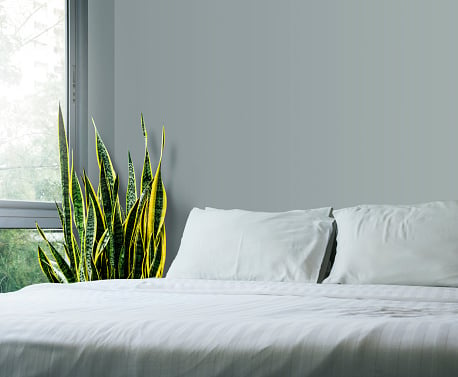
Wittily named, mother-in-law’s tongue adds a sharp edge to your bedroom. Its dark green and yellow tendrils add a vibrant character to your space while cleaning the air of chemicals (yet another plant on NASA’s list).
You won’t have a problem with snake plants producing carbon dioxide at night. It helps promote sleep precisely because they produce oxygen at night.
Large plants like some varieties of snake plants will grow in low light to bright light and has low watering needs.
Peace Lily
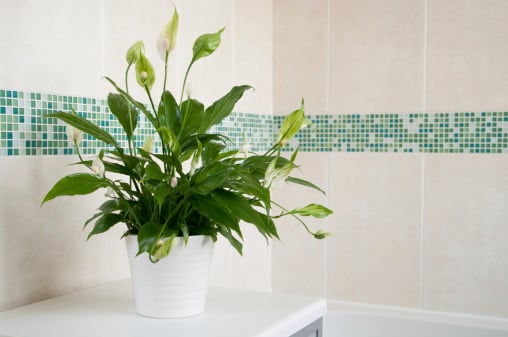
Also studied in NASA’s research, this plant is known for its air-purifying properties. Add to that, the peace lily has the beauty of white blooms to contrast its dark leaves, making them very pleasing to the eyes.
It isn’t hard to care for peace lilies. Give them just a little bit of water and allow them to thrive in the shade. You’ll be good to go.
Gerbera Daisy
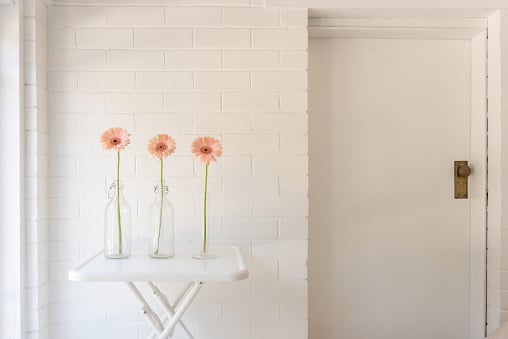
Yet another blooming plant! These daisies are one of the most colourful options for your home. In the bedroom, these beauties can make you feel positive even after a long day.
It isn’t just all looks though. Gerbera daisies were one of the top toxin-clearing plants in NASA’s list so it’s as effective as it is pretty.
Spider Plant
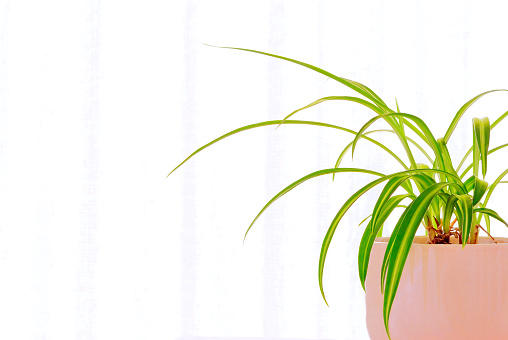
These favourites come in both big and small pots to suit your bedroom space. Also known to help improve air quality based on NASA’s findings, spider plants can aesthetically be used as hanging plants (with the right setup of course) if it suits your room’s style.
Aloe Vera
A popular bright green plant, the aloe vera plant is easy to care for. It can clear the air of pollutants, but it is more widely known for its many healing properties. Pretty convenient to have this plant around, right?
In our opinion, the pros outweigh the cons in the end. Who doesn’t want to have a clean, cool, and calming space to relax in at bedtime? Breathe in the fresh air of your room and appreciate the new indoor air quality.
Thanks to your little green friends, you can breathe better, sleep better, and might be one step closer to the perfect bedroom.



